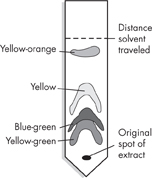Standardized Test Prep
Multiple Choice
Autotrophs differ from heterotrophs because they
utilize oxygen to burn food.
do not require oxygen to live.
make carbon dioxide as a product of using food.
make their own food from carbon dioxide and water.
The principal pigment in plants is
chlorophyll.
oxygen.
ATP.
NADPH.
Which of the following is NOT produced in the light-dependent reactions of photosynthesis?
NADPH
sugars
hydrogen ions
ATP
Which of the following correctly summarizes the process of photosynthesis?
The color of light that is LEAST useful to a plant during photosynthesis is
red.
blue.
green.
violet.
The first step in photosynthesis is the
synthesis of water.
production of oxygen.
breakdown of carbon dioxide.
absorption of light energy.
In a typical plant, all of the following factors are necessary for photosynthesis EXCEPT
chlorophyll.
light.
oxygen.
water.
Questions 8–11
Several drops of concentrated pigment were extracted from spinach leaves. These drops were placed at the bottom of a strip of highly absorbent paper. After the extract dried, the paper was suspended in a test tube containing alcohol so that only the tip of the paper was in the alcohol. As the alcohol was absorbed and moved up the paper, the various pigments contained in the extract separated as shown in the diagram.
Which pigment traveled the shortest distance?
yellow-orange
yellow
blue-green
yellow-green
A valid conclusion that can be drawn from this information is that spinach leaves
use only chlorophyll during photosynthesis.
contain several pigments.
contain more orange pigment than yellow pigment.
are yellow-orange rather than green.
In which organelle would MOST of these pigments be found?
vacuoles
centrioles
mitochondria
chloroplasts
Open-Ended Response
Describe how high-energy electrons are ultimately responsible for driving the photosynthetic reactions.
| Question | 1 | 2 | 3 | 4 | 5 | 6 | 7 | 8 | 9 | 10 | 11 |
|---|---|---|---|---|---|---|---|---|---|---|---|
| See Lesson | 8.1 | 8.2 | 8.2 | 8.2 | 8.2 | 8.3 | 8.3 | 8.2 | 8.2 | 8.2 | 8.3 |
Table of Contents
- Formulas and Equations
- Applying Formulas and Equations
- Mean, Median, and Mode
- Estimation
- Using Measurements in Calculations
- Effects of Measurement Errors
- Accuracy
- Precision
- Comparing Accuracy and Precision
- Significant Figures
- Calculating With Significant Figures
- Scientific Notation
- Calculating With Scientific Notation
- Dimensional Analysis
- Applying Dimensional Analysis






